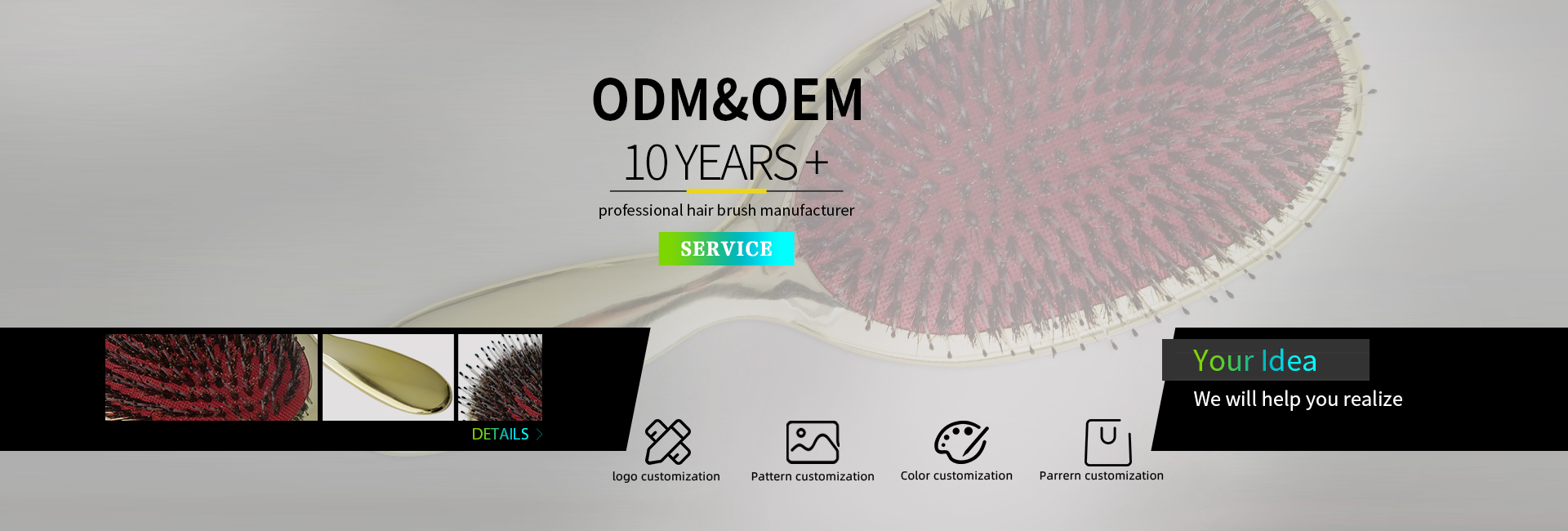I. Understanding Hair Brush Surface Finishes
Surface finishing refers to the application of coatings or effects to the surface of a hair brush to modify its appearance, texture, and functionality. This process plays a pivotal role in enhancing the aesthetic appeal, durability, and user experience of the product. Beyond meeting daily grooming needs, surface finishes allow manufacturers to align with consumer preferences for style, comfort, and longevity, making them a critical aspect of modern hair brush production.
II. Common Types of Surface Finishes
A. Plain Color
- Characteristics: Plain color finishes utilize the natural hue of raw materials such as plastic, wood, or resin, or incorporate simple coloring without additional surface treatments. This approach emphasizes functionality and minimalism.
- Advantages: Cost-effective, environmentally friendly, and conducive to rapid, large-scale production due to the absence of complex processing.
- Applications: Ideal for basic hair brushes designed for everyday use and mass manufacturing.
- Customization Options: Offers a range of basic colors (e.g., black, white, blue, pink) and material choices (e.g., plastic, wood, resin) to cater to diverse preferences.
- Maintenance Tip: Regular cleaning with a toothbrush to reach difficult areas ensures hygiene and extends product lifespan.
B. Spray Coating Process
- Types:
- Rubber Paint: Provides a non-slip surface, enhancing grip and comfort, particularly for handles.
- Metallic Paint: Imparts a shiny, modern appearance with added corrosion resistance.
- Pearlescent Paint: Delivers a color-shifting glossy effect, adding an artistic and unique touch.
- Matte Paint: Offers a subtle sheen and luxurious feel, resistant to fingerprints.
- UV Coating: Utilizes ultraviolet curing for a high-gloss, wear-resistant finish.
- Glossy Coating: Creates a smooth, eye-catching surface, ideal for premium products.
- Advantages: Enhances both durability and visual appeal while remaining environmentally friendly through energy-efficient processes.
- Customization: Manufacturers can explore additional effects by contacting specialists for tailored solutions.
C. Electroplating
- Process: Involves an electrochemical reaction to deposit a metal layer (e.g., chrome, gold, silver) onto the brush surface, often resulting in a mirror-like finish.
- Advantages: Improves wear resistance, corrosion resistance, and oxidation protection, extending product lifespan while offering a sophisticated aesthetic.
- Common Metals:
- Chrome Plating: High gloss and excellent corrosion resistance.
- Gold Plating: Luxurious golden appearance for high-end markets.
- Rose Gold Plating: Warm pink metallic luster, popular in modern designs.
- Silver Plating: Elegant and timeless look.
- Pearlescent Plating: Soft, unique sheen with a pearl-nickel layer.
- Applications: Suited for high-end markets, brand customization, and luxury or limited-edition products.
D. Printing Techniques
- Water Transfer Printing: A method using water as a medium to transfer intricate patterns onto surfaces, adaptable to curved or irregular shapes. It is eco-friendly and excels in producing sophisticated designs, though it may incur higher costs.
- Thermal Transfer Printing: Employs heat and pressure to transfer patterns from paper onto the surface, ideal for mass production with vibrant, durable results. However, it requires specialized equipment and is less effective on complex curves.
- Applications: Water transfer is perfect for high-end, personalized products, while thermal transfer suits large-scale production and brand customization.
III. Benefits of Customizing Surface Finishes
- Brand Differentiation: Unique coatings, colors, and textures create a distinct visual identity, enhancing brand recognition and market competitiveness.
- Enhanced Durability and Performance: Treatments like UV coatings and electroplating boost scratch resistance, while ceramic coatings improve heat resistance, ideal for styling tools.
- Improved User Experience: Glossy coatings offer a comfortable touch, rubber finishes prevent slipping, and matte finishes provide superior grip, enhancing usability.
- Aesthetic Appeal: Custom finishes, such as pearlescent or electroplated surfaces, meet fashion demands and elevate the product’s visual allure.
IV. Questions to Consider When Customizing Surface Finishes
- Target Audience Preferences: Younger consumers may favor vibrant patterns, while professional stylists prioritize durability and heat resistance.
- Material Compatibility: Plastics are well-suited for glossy or UV coatings, whereas wood and metal align with matte or electroplated finishes.
- Production Feasibility and Cost: Evaluate the complexity and equipment needs of processes like water transfer printing, balancing quality with budget constraints.
- Brand and Marketing Strategy: Luxury brands may opt for metallic finishes to convey premium quality, while eco-conscious brands might choose natural textures to reflect sustainability.
V. Conclusion
Surface finishes are essential for enhancing the appearance, functionality, and durability of hair brushes. Customization enables brands to differentiate themselves in a competitive market, meeting the growing demand for personalized, high-quality products. Manufacturers are encouraged to select finishes based on audience preferences, material compatibility, production feasibility, and brand strategy. For expert guidance or tailored solutions, Contacting Professional Teams is recommended to ensure optimal results.
